16 May Dances of Appalachia (Appalachian Heritage Week) with Nancy Mamlin & Kenny Jackson
[vc_row css_animation="" row_type="row" use_row_as_full_screen_section="no" type="full_width"...

[vc_row css_animation="" row_type="row" use_row_as_full_screen_section="no" type="full_width"...
[vc_row css_animation="" row_type="row" use_row_as_full_screen_section="no" type="full_width"...
[vc_row css_animation="" row_type="row" use_row_as_full_screen_section="no" type="full_width"...
We are thrilled to announce...
David Allen Kaynor passed away...
Wishing you a happy May...
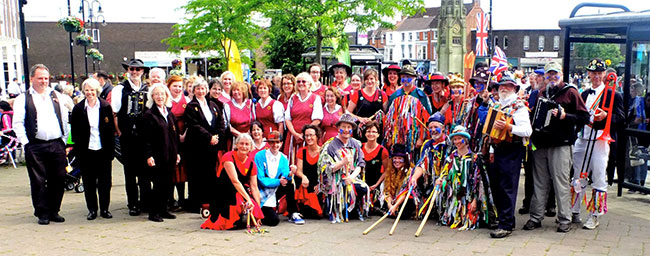 The Brasstown Morris Teams in England. (Carl and his red trombone are on the far right.)[/caption]
There are all sorts of traditions that are alive and well at the Folk School. The Brasstown Fire Department always brings the firetruck to spray down all the children during Little/Middle Folk School, we always dance the Salty Dog Rag during the evening break at Saturday night dances, and the Brasstown Brigade always helps us bring in the New Year with their black powder muskets. One of my favorite Folk School traditions is the Brasstown Follies, the talent show that happens each Winter Dance Week the night before New Years Eve. For as long as I've been coming to Winter Dance Week, the Follies have been organized and MC'ed by Carl Dreher - dancer, musician, magician, and all around Brasstown enthusiast. So enthusiastic, in fact, that he and his wife Charlotte Bristow recently retired and decided to move here from Texas. Let's meet Carl...
[caption id="attachment_12107" align="alignright" width="253"]
The Brasstown Morris Teams in England. (Carl and his red trombone are on the far right.)[/caption]
There are all sorts of traditions that are alive and well at the Folk School. The Brasstown Fire Department always brings the firetruck to spray down all the children during Little/Middle Folk School, we always dance the Salty Dog Rag during the evening break at Saturday night dances, and the Brasstown Brigade always helps us bring in the New Year with their black powder muskets. One of my favorite Folk School traditions is the Brasstown Follies, the talent show that happens each Winter Dance Week the night before New Years Eve. For as long as I've been coming to Winter Dance Week, the Follies have been organized and MC'ed by Carl Dreher - dancer, musician, magician, and all around Brasstown enthusiast. So enthusiastic, in fact, that he and his wife Charlotte Bristow recently retired and decided to move here from Texas. Let's meet Carl...
[caption id="attachment_12107" align="alignright" width="253"]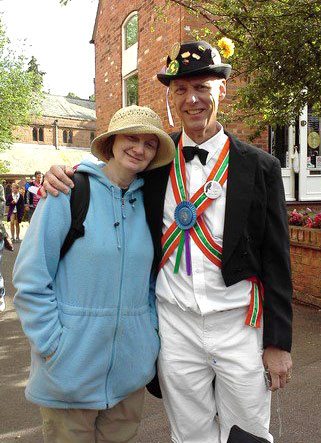 Carl & Charlotte at Kenilworth Castle.
Carl & Charlotte at Kenilworth Castle. 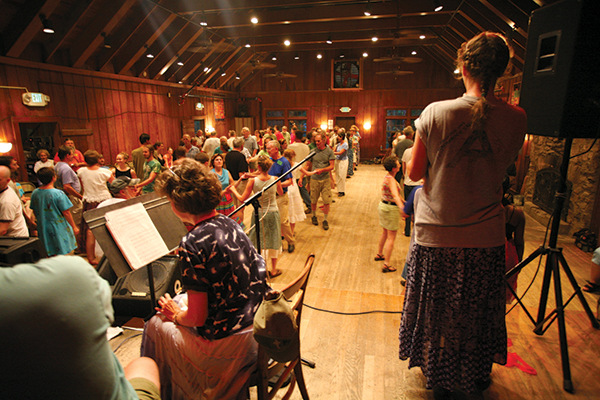 Charlotte calls a contra dance in the Community Room.[/caption]
CP: How long have you been calling at the Folk School?
CC: I came to the Folk School as a Work/Study in the winter of 2006 and I took Bob Dalsemer’s Dance Callers' Workshop that summer. So technically I’ve been calling since 2006, but I wasn’t calling regularly 'till a little time after that.
CP: Why did you get into dance calling?
CC: I’d been a contra dancer for a long time. When I was in elementary, high school and college I was involved in other kinds of dance, so I’ve always had a history of being interested in dancing. I wanted to be a provider of the activity as opposed to just a consumer. Recognizing that my skills as a musician might be a little lacking (laughs), I embraced calling as the next fun way I could be able to do that.
[caption id="attachment_11666" align="alignright" width="340"]
Charlotte calls a contra dance in the Community Room.[/caption]
CP: How long have you been calling at the Folk School?
CC: I came to the Folk School as a Work/Study in the winter of 2006 and I took Bob Dalsemer’s Dance Callers' Workshop that summer. So technically I’ve been calling since 2006, but I wasn’t calling regularly 'till a little time after that.
CP: Why did you get into dance calling?
CC: I’d been a contra dancer for a long time. When I was in elementary, high school and college I was involved in other kinds of dance, so I’ve always had a history of being interested in dancing. I wanted to be a provider of the activity as opposed to just a consumer. Recognizing that my skills as a musician might be a little lacking (laughs), I embraced calling as the next fun way I could be able to do that.
[caption id="attachment_11666" align="alignright" width="340"]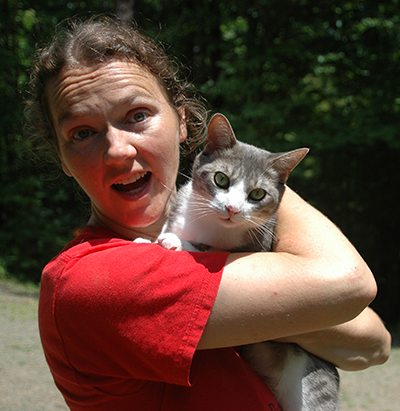 Charlotte & Charlie[/caption]
CP: What’s the best thing about calling a dance at the Folk School?
CC: What a good question! I’d say the dance community at the Folk School is one of the best for integrating all kinds of different folks. People who have been dancing for years and years and years are dancing on the same floor as those who have never ever done it before. Little kids all the way up to folks in their 70s and 80s - all on the same dance floor and everyone’s having a great time, enjoying each other's company. That’s the best part!
CP: Do you have a favorite tune?
CC: I really like the old time tune called Growling & Grumbling, which I love as a dance tune. It got this great low, mumbly beginning and then it busts into this fun, upbeat tune.
CP: Is that the same tune as Growling Old Man and Grumbling Old Woman?
CC: Yep! That’s the one! It a great tune.
CP: Where do you get your dances from?
CC: Oh goodness! Lots of sources. Primarily (and I’d say traditionally) from other callers, but also from going to other dances. I’ll go to a dance and enjoy something that I just danced, run over to the side and write it down real quick.
So I collect dances from dancing. I collect dances from other callers. And in our modern day & age, the internet is a wonderful place, not only to collect dances right off the web, but also to find literature from different places. I use the Country Dance & Song Society which is an organization up in Massachusetts that promotes folk dance and music. I peruse their bookstore pretty frequently. They are a great resource for all things dance.
Charlotte & Charlie[/caption]
CP: What’s the best thing about calling a dance at the Folk School?
CC: What a good question! I’d say the dance community at the Folk School is one of the best for integrating all kinds of different folks. People who have been dancing for years and years and years are dancing on the same floor as those who have never ever done it before. Little kids all the way up to folks in their 70s and 80s - all on the same dance floor and everyone’s having a great time, enjoying each other's company. That’s the best part!
CP: Do you have a favorite tune?
CC: I really like the old time tune called Growling & Grumbling, which I love as a dance tune. It got this great low, mumbly beginning and then it busts into this fun, upbeat tune.
CP: Is that the same tune as Growling Old Man and Grumbling Old Woman?
CC: Yep! That’s the one! It a great tune.
CP: Where do you get your dances from?
CC: Oh goodness! Lots of sources. Primarily (and I’d say traditionally) from other callers, but also from going to other dances. I’ll go to a dance and enjoy something that I just danced, run over to the side and write it down real quick.
So I collect dances from dancing. I collect dances from other callers. And in our modern day & age, the internet is a wonderful place, not only to collect dances right off the web, but also to find literature from different places. I use the Country Dance & Song Society which is an organization up in Massachusetts that promotes folk dance and music. I peruse their bookstore pretty frequently. They are a great resource for all things dance.
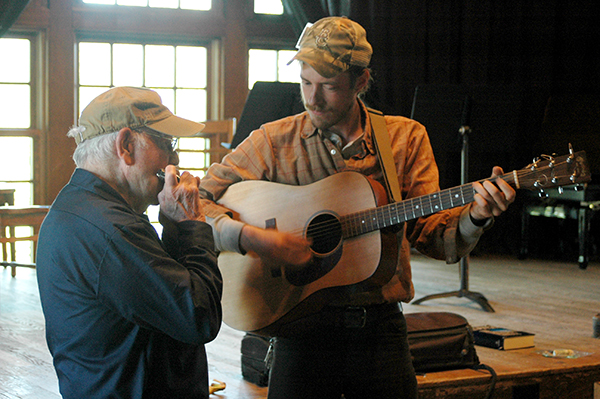 Cory and fellow Tinsmithing student play music in the Community Room after Show and Tell[/caption]
Cory and fellow Tinsmithing student play music in the Community Room after Show and Tell[/caption]
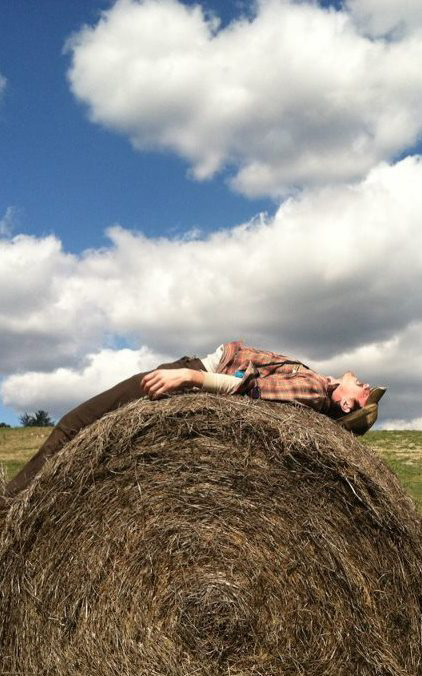 Laying on the hay in the Folk School field[/caption]
Laying on the hay in the Folk School field[/caption]
CP: When were you a Work/Study?
CS: March 14 – May 15, 2010. I remember the date clearly because I recall being mesmerized by the St. Patrick’s Day Party at the Murphy L & N Train Depot. Dale’s imitation of a leprechaun trapped in a brown paper bag - I thought that was brilliant!
CP: What have you been up to since your W/S session?
CS:I am currently a student at Berea College. I have been there for three years pursuing my undergraduate degree. I’ve also done a bit of working and traveling. I went to Ireland and Japan with the Berea Bluegrass Band. For a while before I went to Berea, I was working with Meredith Dahle (former host) at Sugarboo Farms in Blairsville. That was great because I could still be involved at the Folk School.


